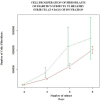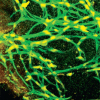Oral mucosa: an alternative epidermic cell source to develop autologous dermal-epidermal substitutes from diabetic subjects
- PMID: 28403359
- PMCID: PMC5393539
- DOI: 10.1590/1678-77572016-0217
Oral mucosa: an alternative epidermic cell source to develop autologous dermal-epidermal substitutes from diabetic subjects
Abstract
Objective: The aim of this study was to obtain autologous dermal-epidermal skin substitutes from oral mucosa from diabetic subjects as a first step towards a possible clinical application for cases of diabetic foot.
Material and methods: Oral mucosa was obtained from diabetic and healthy subjects (n=20 per group). Epidermal cells were isolated and cultured using autologous fibrin to develop dermal-epidermal in vitro substitutes by the air-liquid technique with autologous human serum as a supplement media. Substitutes were immunocharacterized with collagen IV and cytokeratin 5-14 as specific markers. A Student´s t- test was performed to assess the differences between both groups.
Results: It was possible to isolate epidermal cells from the oral mucosa of diabetic and healthy subjects and develop autologous dermal-epidermal skin substitutes using autologous serum as a supplement. Differences in the expression of specific markers were observed and the cytokeratin 5-14 expression was lower in the diabetic substitutes, and the collagen IV expression was higher in the diabetic substitutes when compared with the healthy group, showing a significant difference.
Conclusion: Cells from oral mucosa could be an alternative and less invasive source for skin substitutes and wound healing. A difference in collagen production of diabetic cells suggests diabetic substitutes could improve diabetic wound healing. More research is needed to determine the crosstalk between components of these skin substitutes and damaged tissues.
Figures






Similar articles
-
Wound-healing factors secreted by epidermal keratinocytes and dermal fibroblasts in skin substitutes.Wound Repair Regen. 2007 Sep-Oct;15(5):708-17. doi: 10.1111/j.1524-475X.2007.00280.x. Wound Repair Regen. 2007. PMID: 17971017
-
Higher numbers of autologous fibroblasts in an artificial dermal substitute improve tissue regeneration and modulate scar tissue formation.J Pathol. 2000 Apr;190(5):595-603. doi: 10.1002/(SICI)1096-9896(200004)190:5<595::AID-PATH572>3.0.CO;2-V. J Pathol. 2000. PMID: 10727986
-
Vitamin C regulates keratinocyte viability, epidermal barrier, and basement membrane in vitro, and reduces wound contraction after grafting of cultured skin substitutes.J Invest Dermatol. 2002 Apr;118(4):565-72. doi: 10.1046/j.1523-1747.2002.01717.x. J Invest Dermatol. 2002. PMID: 11918700
-
Skin substitutes for acute and chronic wound healing: an updated review.J Dermatolog Treat. 2020 Sep;31(6):639-648. doi: 10.1080/09546634.2018.1530443. Epub 2020 Jan 30. J Dermatolog Treat. 2020. PMID: 30265595 Review.
-
Current Status and Future of Skin Substitutes for Chronic Wound Healing.J Cutan Med Surg. 2017 Jan/Feb;21(1):23-30. doi: 10.1177/1203475416664037. Epub 2016 Aug 20. J Cutan Med Surg. 2017. PMID: 27530398 Review.
Cited by
-
New Gene Markers for Metabolic Processes and Homeostasis in Porcine Buccal Pouch Mucosa during Cells Long Term-Cultivation-A Primary Culture Approach.Int J Mol Sci. 2018 Mar 29;19(4):1027. doi: 10.3390/ijms19041027. Int J Mol Sci. 2018. PMID: 29596348 Free PMC article.
-
Blood Plasma, Fibrinogen or Fibrin Biomaterial for the Manufacturing of Skin Tissue-Engineered Products and Other Dermatological Treatments: A Systematic Review.J Funct Biomater. 2025 Feb 22;16(3):79. doi: 10.3390/jfb16030079. J Funct Biomater. 2025. PMID: 40137358 Free PMC article. Review.
-
Descriptive proteomics of paired human vocal fold and buccal mucosa tissue.Proteomics Clin Appl. 2022 Mar;16(2):e2100050. doi: 10.1002/prca.202100050. Epub 2021 Dec 1. Proteomics Clin Appl. 2022. PMID: 34792860 Free PMC article.
-
Recent trends and perspectives in reconstruction and regeneration of intra/extra-oral wounds using tissue-engineered oral mucosa equivalents.Jpn Dent Sci Rev. 2023 Dec;59:365-374. doi: 10.1016/j.jdsr.2023.10.002. Epub 2023 Oct 25. Jpn Dent Sci Rev. 2023. PMID: 37954029 Free PMC article. Review.
-
Biological properties and characterization of several variations of a clinical human plasma-based skin substitute model and its manufacturing process.Regen Biomater. 2024 Sep 26;11:rbae115. doi: 10.1093/rb/rbae115. eCollection 2024. Regen Biomater. 2024. PMID: 39469583 Free PMC article.
References
-
- American Diabetes Association Diagnosis and classification of diabetes mellitus. Diabetes Care. 2014;37(Suppl.1):S81–S90. - PubMed
-
- Berlanga-Acosta J, Valdéz-Pérez C, Savigne-Gutiérrez W, Mendoza-Marí Y, Franco-Pérez N, Vargas-Machiran E, et al. Cellular and molecular insights into the wound healing mechanism in diabetes. Biotecnol Apl. 2010;27(4):255–261.
MeSH terms
Substances
LinkOut - more resources
Full Text Sources
Other Literature Sources
Medical
Research Materials

